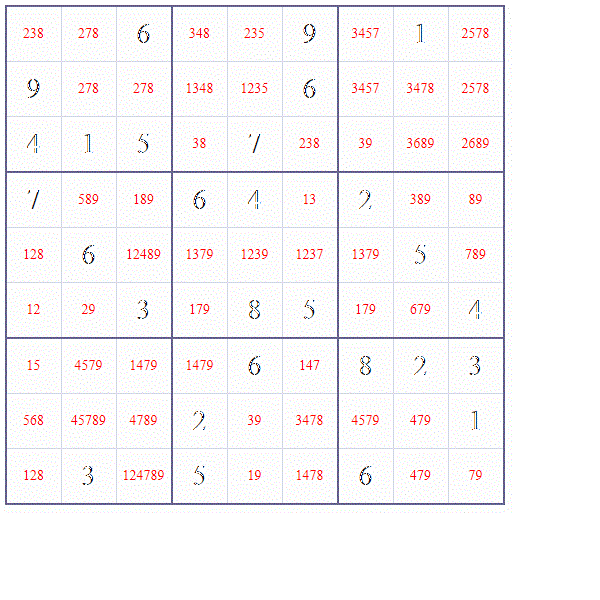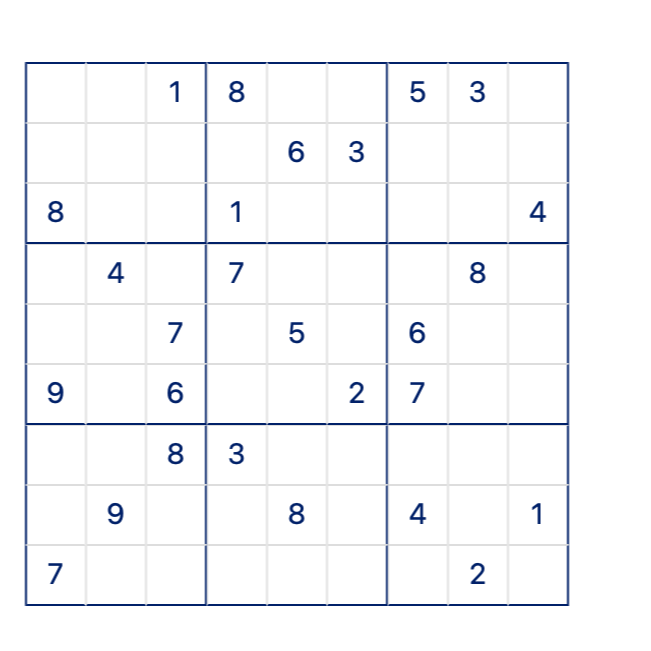Introduction to Sudoku and Its Popularity
Sudoku, a brain-teasing puzzle game, has captured the minds of millions. Originating from Japan, its name means ‘single number’. It has now become a daily staple for puzzle enthusiasts around the globe. Sudoku involves filling a 9×9 grid with numbers. Each row, column, and 3×3 subgrid must contain all digits from 1 to 9 without repetition. Its popularity soared due to its simple rules yet challenging gameplay. Despite its basic concept, Sudoku puzzles range from easy to extremely difficult. It’s the perfect balance that can both entertain beginners and challenge seasoned solvers. Numerous studies show that regularly solving Sudoku can improve logic and problem-solving skills. This game has found its way into newspapers, websites, and mobile apps, making it widely accessible. The rise in Sudoku’s popularity can be attributed to the satisfaction it gives upon completing a challenging grid. With the proliferation of difficult Sudoku puzzles, players continuously seek effective strategies to conquer these mind-benders.
Fundamental Techniques for Solving Sudoku
Before diving into the complex methods, understanding the basic techniques is crucial. These foundational strategies provide the groundwork for tackling difficult Sudoku puzzles effectively. By mastering these techniques, players enhance their ability to identify opportunities and eliminate impossibilities in the grid.

The Single Candidate Method
The Single Candidate Method is one of the simplest yet most effective approaches to solving Sudoku. In this method, you look for cells where only one number can possibly fit. This happens when every other number from 1 to 9 appears in the same row, column, or 3×3 subgrid, leaving only one possible option for that particular cell. Focusing on one cell at a time, players can unravel the puzzle gradually, ensuring certainty in every step they take.
The Single Position Technique
The Single Position Technique complements the Single Candidate Method by focusing on the numbers instead of the cells. Here, you determine where a particular number must go within a row, column, or subgrid based on the elimination of other possible positions. If every other cell in a row can be filled only by other numbers, then the remaining cell must contain the specific number you are considering. This technique requires careful analysis and keen observation to spot the unique solutions that often go unnoticed in difficult puzzles.
Advanced Strategies for Difficult Sudoku
For those who have mastered basic techniques, difficult Sudoku puzzles require more advanced strategies. These tactics involve identifying patterns and using elimination methods not obvious at first glance.
The Naked Pairs, Triples, and Quads
When solving difficult sudoku, look for ‘naked pairs, triples, or quads’ in the grid. These are sets of two, three, or four cells in a row, column, or subgrid that contain only the same possible numbers. For example, if two cells in a row can only be a 5 or a 7, these create a naked pair. Any other cell in that row cannot be a 5 or a 7. This strategy can be scaled up to triples and quads. It helps to reduce the number of possibilities in other cells.
The X-Wing Strategy
The X-Wing is a powerful technique used when a number appears in exactly two spots across two different rows and also aligns within the same columns. By drawing imaginary lines to form an ‘X’, you can eliminate that number from appearing in those columns in other rows. This technique is particularly useful when the puzzle seems to have reached a standstill.
The Swordfish and Jellyfish Patterns
Similar to the X-Wing, the Swordfish and Jellyfish patterns are used to eliminate possibilities across multiple rows and columns. The Swordfish pattern involves three rows and three columns, while the Jellyfish uses four. When a specific number appears only in the same three spots in separate rows and aligns across columns, that’s your Swordfish. The Jellyfish is another step up, using four rows and four columns. Spotting these patterns can swiftly narrow down your choices and unlock new moves in difficult puzzles.
Pencil Marking and Its Importance in Difficult Sudoku
Pencil marking is a pivotal strategy when solving difficult sudoku puzzles. This technique involves lightly marking all possible numbers for each cell in the grid. These marks are tentative, helping solvers keep track of potential solutions without committing to them immediately. As the puzzle progresses, these markings can be updated or erased based on new information and eliminations.

Pencil marking plays a crucial role, especially in intricate Sudoku grids where the number of possibilities can be overwhelming. It allows players to visualize potential placements and identify advanced patterns such as naked pairs or X-Wings more easily. This visualization aids significantly in reducing errors, ensuring clearer progression throughout the puzzle-solving process. Additionally, pencil marking prepares the stage for efficient trial and error strategies, where candidates can be systematically tested and verified.
For many seasoned solvers, using pencil markings is indispensable. It transforms an intimidating puzzle into a systematically solvable problem by unraveling hidden possibilities one step at a time. Thus, understanding and utilizing this method can dramatically enhance one’s ability to tackle the most challenging Sudoku puzzles effectively.
The Role of Logic and Elimination
When tackling difficult sudoku puzzles, the power of logic and the process of elimination become pivotal. These two approaches are intertwined and form the backbone of effective sudoku solving strategies. Logic is used to deduce the next plausible steps, while elimination removes the impossibilities that cannot be part of the solution.
In practice, every move in a sudoku puzzle should be grounded in logical reasoning. Consider a cell where several numbers might fit. The logical approach evaluates which numbers are already present in the corresponding row, column, and subgrid. Then, it concludes which digit is the right fit. This narrows options and may reveal the single possible answer.
The elimination process works hand-in-hand with logic. It often involves a series of ‘what if’ scenarios. For instance, if a number were placed here, would it conflict with another cell within the same row, column, or subgrid? If so, that number can be struck off the list of possibilities for that particular cell.
Together, logic and elimination strategies help to maintain a clear path forward and prevent guesswork. This is particularly important when dealing with difficult sudoku puzzles where the margin for error is slim. Consistent application of logic and strategic elimination can help decode even the trickiest grids, leading solvers to that satisfying conclusion of filling in the last number.
Using these methods wisely, players can solve difficult sudoku puzzles more efficiently. These approaches train the mind to spot patterns and to think several steps ahead. They transform seemingly impossible challenges into solvable ones, one digit at a time.
Time Management and Patience in Solving Difficult Puzzles
Solving difficult sudoku puzzles is not just about skill. Time management and patience are also key. You may feel stuck at times, but with patience, solutions often emerge. Manage your time well by setting realistic goals for each session. Don’t rush; hasty choices lead to errors. Instead, take a step back if needed, and review your moves. Prioritize tricky sections and solve easier parts to build momentum. Keep track of time spent on the puzzle to avoid fatigue. Remember, breaks are important. They refresh your mind, helping you see overlooked patterns. With practice, you’ll solve difficult sudoku faster and with greater accuracy. Stay patient, think logically, and manage your time for success.
Using Sudoku Solvers and Software Assistance
In the quest to conquer difficult sudoku puzzles, solvers and software can be powerful allies. These tools offer various features that can assist players in moments of uncertainty. Solvers often include hint functions. These functions guide you when you’re stuck, without giving away the solution right off. They suggest possible moves, which can help improve your skills over time.
Software programs provide a digital platform for puzzle-solving. Users can easily input numbers and trial possibilities. They can also quickly erase mistakes, all with simple clicks or taps. Many such programs include analytic features. These analyze the puzzle and point out patterns or strategies you might miss.
Some solvers even allow you to simulate ‘what if’ scenarios. This is without disrupting the current state of the puzzle. Others highlight errors, helping avoid repeated missteps. The beauty of these tools is that they can cater to various levels. Beginners can use the basic functionalities. More experienced players can delve into the more advanced options.
At this stage, it is important to mention the key feature — pencil marking. This digital equivalent mimics the traditional method. It allows players to note all potential numbers for a cell. This electronic help can lead to clearer, quicker decisions during gameplay.
While software tools are helpful, reliance on them should be balanced. Building your own logic and problem-solving skills is equally essential. A strategic mix of personal skills and software aid can sharpen your mind. It can also make the process of solving difficult sudoku puzzles more enjoyable and satisfying. As you progress, aim to use hints less. Try to solve more complex puzzles on your own. This will ensure that your abilities continue to grow.



